Kneel into the mysteries of Old Testament miracles to unveil timeless lessons of faith and power that resonate today.
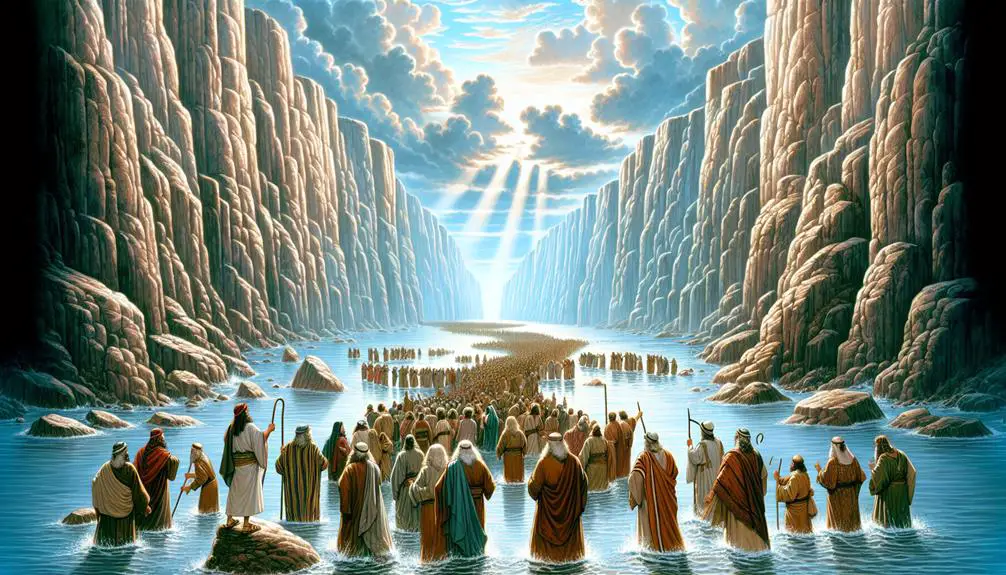
Miracles in the Bible Old Testament
You might think that the miracles in the Old Testament are just ancient tales, but they hold profound insights and enduring lessons. As you explore these events, from the creation of the world to Elijah's challenge on Mount Carmel, you'll find that they're not merely stories. They embody themes of faith, power, and redemption that resonate through time.
Each miracle, whether it's Moses parting the Red Sea or the walls of Jericho falling, offers a unique lens through which to view the complex relationship between humanity and the divine. So, why not take a closer look at these narratives? You might discover connections and meanings that are surprisingly relevant to your own life.
Key Takeaways
- The Old Testament features miracles of nature, such as the parting of the Red Sea in Exodus 14:21-22.
- Miracles of provision, like manna from heaven in Exodus 16:14-15, highlight God's care for His people.
- Prophets like Elijah and Elisha performed miracles of healing and resurrection, demonstrating God's power over life and death.
- Miracles of deliverance, including Daniel in the lion's den, show God's ability to protect and save His faithful followers.
The Creation of the World

In the Old Testament, the act of creation unfolds as God methodically brings the universe into existence, demonstrating a profound interplay of power and purpose. This narrative, while deeply spiritual, invites you to explore the concept of creation from a cosmic timescale, integrating an evolutionary perspective that enriches your understanding of the origins of life and the universe.
The text delineates creation across six days, a framework that, when viewed through the lens of modern science, aligns metaphorically with the stages of cosmic evolution. This interpretation allows you to appreciate the biblical account not only as a religious explanation but also as a poetic representation of the unfolding of the cosmos over billions of years. The notion of a cosmic timescale bridges the gap between faith and science, suggesting that the biblical days of creation might symbolize phases of development in the universe's history.
From an evolutionary perspective, the sequence of creation—from light and darkness to the emergence of life on earth—mirrors the scientific understanding of the universe's progression. This parallel invites you to consider the Old Testament's creation story as an allegorical expression of the natural world's complexity and beauty, rather than a literal account of historical events.
Noah's Ark and the Flood
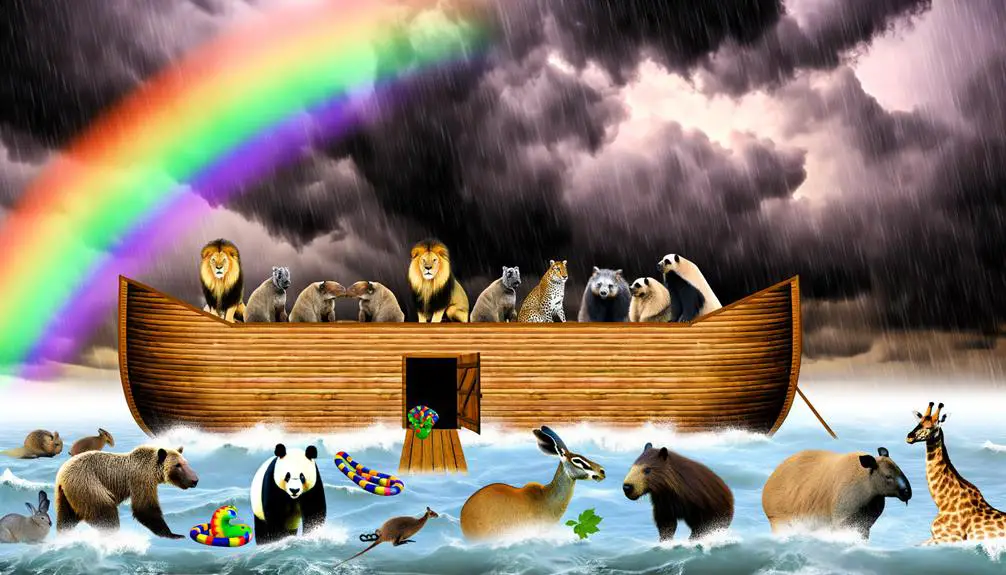
Amidst the narratives of the Old Testament, the story of Noah's Ark and the Flood stands out as a pivotal event that showcases divine intervention and human resilience. This account, deeply engraved in religious and cultural consciousness, provides a profound exploration of themes like obedience, faith, and redemption. It's also an early testament to the concepts of animal preservation and the drastic effects of climate change on human and animal existence.
The tale begins with a world corrupted by human sinfulness, prompting God to cleanse the earth through a flood. Yet, in this act of judgment, God's mercy shines through the preservation of Noah, his family, and representatives of the animal kingdom. This narrative invites you to ponder the significance of environmental stewardship and the balance between divine justice and mercy.
Aspect |
Description |
Implications |
|---|---|---|
Divine Intervention |
God instructs Noah to build an ark. |
Showcases a supernatural response to human actions. |
Human Resilience |
Noah's obedience in the face of universal destruction. |
Highlights the capacity for faith and action under divine guidance. |
Animal Preservation |
Two of every kind of animal are saved. |
Early recognition of the importance of biodiversity. |
The story of Noah's Ark and the Flood stands as a compelling narrative that intersects faith, ethics, and the natural world. It challenges you to reflect on the relationship between human actions, divine will, and the environment. The preservation of life amidst destruction serves as a powerful reminder of the potential for renewal and hope in the face of overwhelming challenges, including modern concerns like climate change.
The Tower of Babel
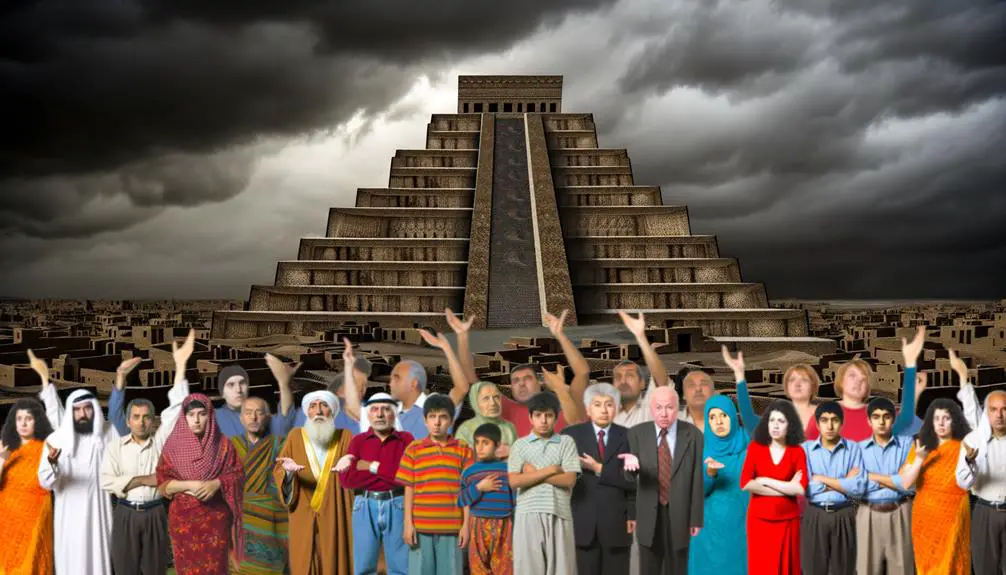
You'll find that the Tower of Babel's narrative centers on themes of origin and purpose, highlighting human ambition and divine will.
This story exemplifies divine intervention, showcasing a pivotal moment where language and communication undergo a profound transformation.
Furthermore, its cultural impact is significant, influencing a myriad of interpretations and discussions across various disciplines and societies.
Origin and Purpose
Exploring the origin and purpose of the Tower of Babel reveals a pivotal moment in biblical narratives, underscoring human ambition and divine intervention. This story, nestled among tales of miraculous healings and prophetic visions, serves as a critical examination of humanity's desire for unity and supremacy.
The construction of the Tower is portrayed as an act of collective pride, aiming to create a monument to human achievement and a means to prevent dispersion across the earth. This ambition reflects a fundamental human trait: the desire to reach beyond our grasp, to touch the divine. Yet, it also underscores a moment of profound misunderstanding between humanity's aspirations and the divine plan, setting the stage for a dramatic divine response.
Divine Intervention
In the narrative of the Tower of Babel, divine intervention serves as a crucial turning point, highlighting the limits of human ambition when confronted with the will of the divine. This episode underscores a profound theological insight: despite humanity's technological prowess and collective efforts, they remain subject to divine sovereignty.
Unlike other Old Testament accounts featuring angelic visitations and prophetic visions as mediums of divine communication, the Tower of Babel story uniquely demonstrates direct divine action to confound and disperse. This act of scattering humanity and confusing their language not only curtails their unified rebellion but also emphasizes the theme of dependency on divine guidance.
It's a narrative that invites reflection on the relationship between human achievement and divine authority, without the intermediaries of angelic or visionary experiences.
Cultural Impact
Throughout history, the Tower of Babel's story has profoundly influenced cultural perceptions of language diversity and human unity. Modern interpretations often view this narrative as a metaphor for the challenges and beauty found in our world's myriad languages and cultures. It's fascinating to observe how societal norms and values are mirrored in the way this story is told and understood.
You'll notice that discussions around the Tower of Babel tend to highlight themes of ambition, pride, and the consequences of human actions, reflecting broader societal concerns about cooperation, communication, and the risks of misunderstanding. This ancient story, thus, serves as a lens through which you can examine contemporary issues related to language, identity, and community in a globalized world.
Sodom and Gomorrah's Destruction
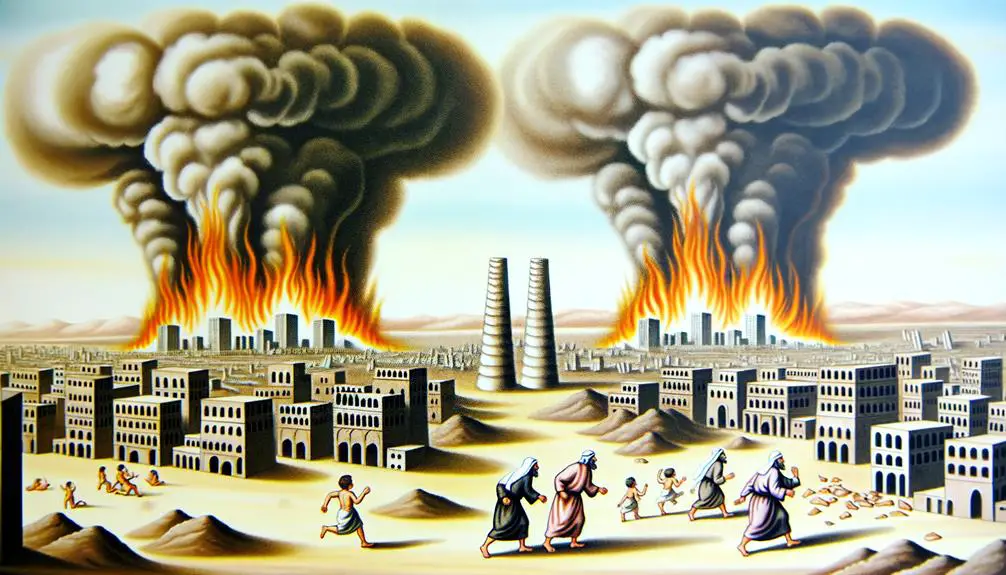
Miracles in the Old Testament
PREVIOUS SUBTOPIC: 'Cultural Impact'
CURRENT SUBTOPIC: 'Sodom and Gomorrah's Destruction'
One of the most striking miracles recorded in the Old Testament is the destruction of Sodom and Gomorrah, cities condemned for their grievous sins. This event not only exemplifies divine judgment but also serves as a somber reminder of the consequences of moral decay.
The narrative highlights Lot's escape, facilitated by an angelic warning, underscoring a theme of mercy amidst judgment. These angels, sent by God, arrived in Sodom and were offered hospitality by Lot. As the night progressed, the men of Sodom surrounded Lot's house, demanding the guests be brought out to them. In response to this and the city's cumulative wickedness, the angels instructed Lot to flee with his family, warning them not to look back as they escaped. This act of deliverance contrasts sharply with the subsequent divine punishment that befell the cities, illustrating a complex interplay of justice and grace.
Aspect |
Emotional Impact |
|---|---|
Divine Judgment |
Evokes a sense of awe and fear towards divine power. |
Lot's Escape |
Inspires relief and gratitude for divine mercy. |
Cities' Destruction |
Instills a solemn warning against moral corruption. |
Analyzing the destruction of Sodom and Gomorrah through this lens reveals a multifaceted miracle. It wasn't merely an act of annihilation but also a profound demonstration of divine intervention, justice, and mercy, serving as a crucial lesson for subsequent generations.
Joseph's Dreams and Rise to Power
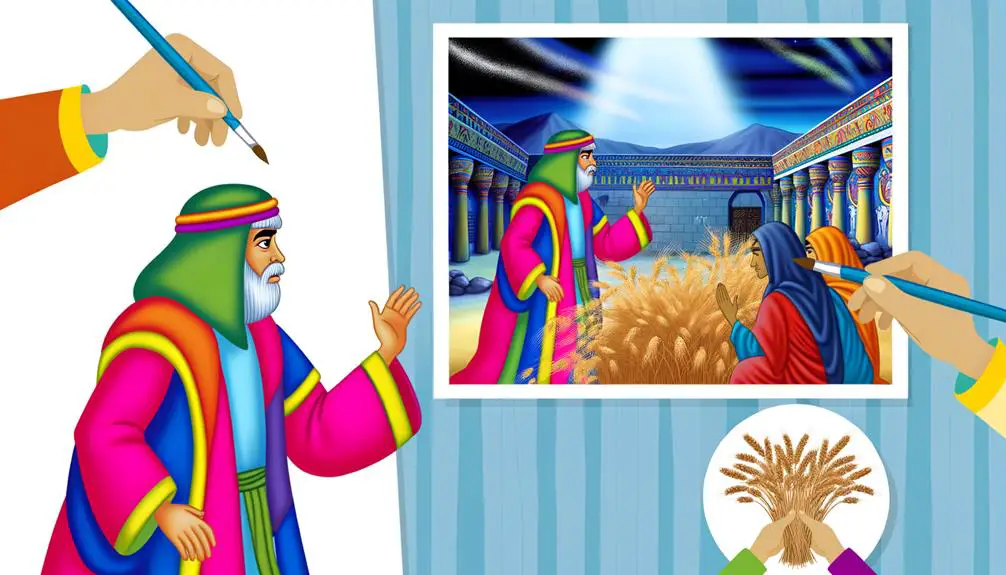
Joseph's dreams, acting as divine revelations, catalyzed his ascent from a favored son to a paramount figure in Egypt, showcasing a remarkable narrative of providential elevation amidst adversity. Initially, Joseph's dreams of his family's sheaves bowing to his sheaf, and the sun, moon, and eleven stars bowing to him, weren't mere flights of fancy but pivotal moments predestining his future leadership and wisdom. These dreams, laden with prophetic significance, sowed the seeds of envy among his brothers, leading to his sale into slavery. Yet, this seeming misfortune set the stage for Joseph's divine appointment to a role that wouldn't only save Egypt but also his family from famine.
Your understanding of dream interpretation emerges as a crucial skill that Joseph possessed, distinguishing him in Pharaoh's court. After accurately interpreting Pharaoh's dreams of seven lean cows devouring seven fat cows and seven withered ears of grain swallowing seven healthy ones, Joseph's insight was recognized as divinely inspired wisdom. This led to his appointment as Egypt's prime minister, tasked with managing the nation's agricultural resources.
Joseph's economic strategies, particularly his implementation of a plan to store surplus grain during seven years of plenty to prepare for seven years of famine, underscore his adeptness in administrative and economic planning. These strategies not only averted disaster for Egypt but also positioned Joseph as a figure of salvation, reconciling him with his family and fulfilling the divine revelations manifested in his dreams. Through Joseph's story, the power of dream interpretation and strategic economic planning is illuminated as instruments of divine providence and redemption.
Moses Parting the Red Sea
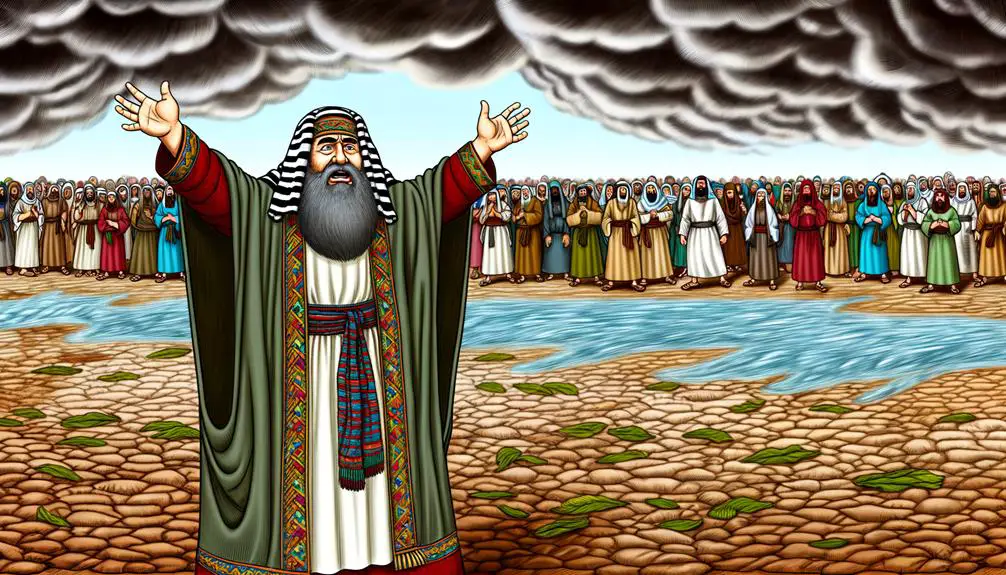
One of the most dramatic and miraculous events in the Old Testament is Moses parting the Red Sea, a pivotal act that enabled the Israelites' escape from Egyptian bondage. This extraordinary event not only showcases the power wielded by Moses through divine intervention but also underlines the significance of faith and obedience in the face of insurmountable obstacles.
The account of Moses parting the Red Sea is rich in symbolic and literal interpretations, particularly concerning the Red Sea ecology and the hardening of Pharaoh's heart. Scholars have debated the ecological plausibility of such an event, considering natural phenomena that could explain the parting of the sea. However, the narrative emphasizes the miraculous nature of the event, transcending ordinary ecological explanations and pointing towards a divine orchestration specifically intended to facilitate the Israelites' escape.
Moreover, the hardening of Pharaoh's heart, mentioned repeatedly in the narrative, illustrates a crucial aspect of the divine-human interaction. It signifies a deliberate divine intervention that ensures the fulfillment of the prophesied liberation of the Israelites. This act of hardening Pharaoh's heart, which led to his persistent refusal to release the Israelites, serves to magnify the magnitude of the miracle and the ultimate demonstration of divine power over human obstinacy and natural laws.
In analyzing the parting of the Red Sea, it becomes evident that the event isn't merely a historical or ecological anomaly but a profound theological statement about faith, deliverance, and the omnipotence of God. It stands as a testament to the belief in divine providence and the possibility of miracles in the face of despair and oppression.
The Walls of Jericho Fall
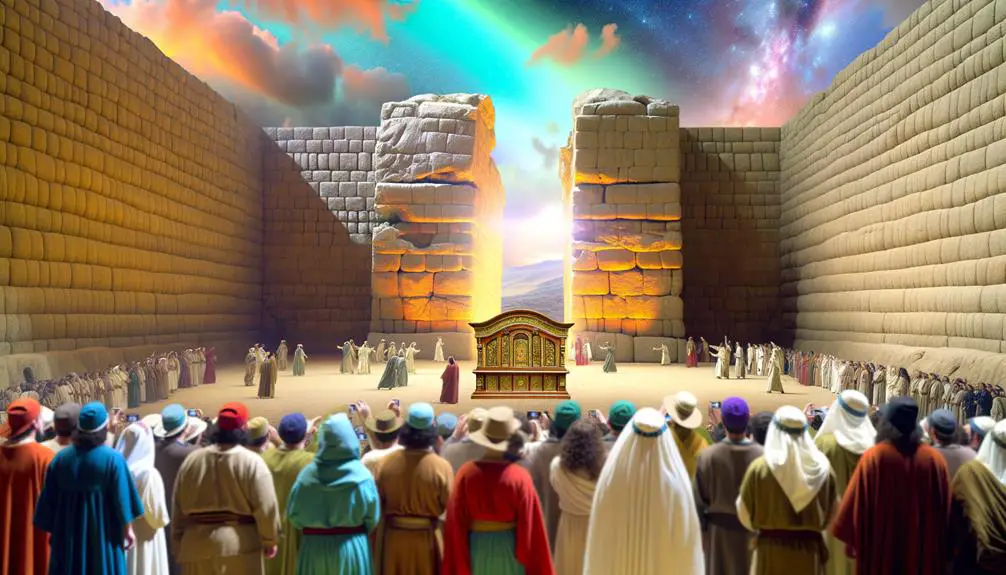
You'll now explore how the narrative of the walls of Jericho falling intersects with historical battle strategies and archaeological findings. This examination sheds light on the complexities surrounding this biblical event, comparing scriptural accounts with tangible evidence.
It offers a nuanced understanding of what might've occurred at Jericho, challenging and enriching traditional interpretations.
Battle Strategies Unveiled
The fall of Jericho's walls represents a pivotal moment in biblical history, showcasing a unique battle strategy that diverges significantly from conventional military tactics. Unlike typical siege tactics, which rely on prolonged encampments, starvation, or diplomatic negotiations to weaken the enemy, the strategy employed at Jericho was markedly different.
It didn't involve negotiations or traditional forms of siege warfare. Instead, it revolved around faith-based actions, including the Israelites' march around the city and the subsequent collapse of its walls, as dictated by divine instruction. This approach underscores a departure from reliance on human negotiation skills or military prowess, highlighting a strategy where faith and obedience to divine commands played a central role.
This narrative invites a scholarly analysis of the interplay between faith, obedience, and military success in ancient texts.
Archaeological Evidence Explored
While exploring the archaeological evidence regarding the fall of Jericho's walls, scholars have encountered a complex interplay of data and interpretations that challenge simplistic historical narratives.
The use of advanced dating methods has been pivotal in piecing together the timeline of events. These techniques, coupled with meticulous artifact preservation efforts, have provided a clearer picture of the era.
However, the evidence doesn't always neatly align with the biblical account. Discrepancies in carbon dating results and the stratigraphic layers where artifacts were found raise questions about the exact timing and nature of Jericho's fall.
As you delve deeper, it becomes evident that understanding this historical event requires a nuanced consideration of both the archaeological evidence and the limitations inherent in dating and preserving ancient relics.
Elijah's Challenge on Mount Carmel
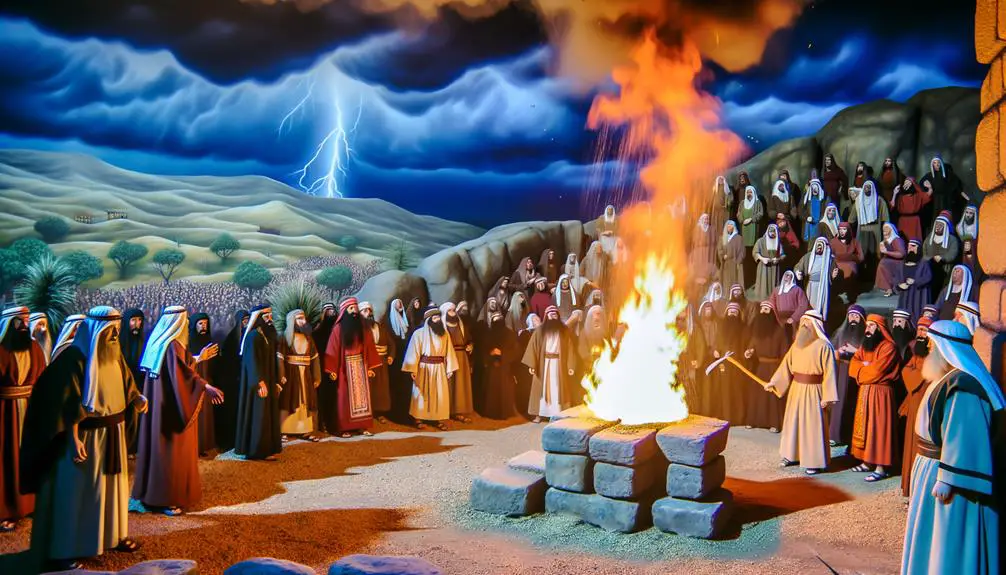
Elijah's bold challenge on Mount Carmel stands out as a pivotal moment in demonstrating the power of faith against polytheistic practices. This event, detailed in the narrative, showcases the prophet's perseverance against the backdrop of a three-year drought. In a dramatic confrontation, Elijah calls upon the people of Israel to choose between the Canaanite god Baal and the God of Israel. The challenge culminates in a supernatural display, where only Elijah's God responds with fire from heaven, consuming the sacrificial offering. This act leads to the rain's return, ending the prolonged drought and affirming the sovereignty of Israel's God.
Element |
Description |
Significance |
|---|---|---|
Prophet's Perseverance |
Despite being outnumbered by Baal's prophets, Elijah stands firm in his faith, orchestrating the challenge. |
Demonstrates unwavering faith and courage in the face of adversity. |
Supernatural Fire |
Fire descends from heaven, consuming Elijah's water-drenched sacrifice. |
Validates the power and presence of the God of Israel as supreme. |
Rain's Return |
Following the challenge, Elijah prays, and rain returns to the drought-stricken land. |
Symbolizes the restoration of God's blessing upon Israel following the people's reaffirmation of faith. |
Defeat of Baal's Prophets |
The prophets of Baal are unable to evoke any response from their deity and are subsequently defeated. |
Marks a decisive victory for monotheism, eradicating the influence of Baal worship among the Israelites. |
This narrative not only underscores the importance of faith and monotheism but also the power of divine intervention in affirming the covenant between God and His people.
Frequently Asked Questions
How Do Scholars Differentiate Between Metaphorical and Literal Interpretations of Miracles in the Old Testament?
When you're diving into how scholars distinguish between metaphorical and literal interpretations, they primarily use textual criticism and hermeneutical approaches. These methods help you scrutinize the texts closely, considering historical, cultural, and linguistic contexts.
Are There Any Recorded Instances of Similar Miracles Occurring in Other Ancient Cultures or Religions Outside of the Bible?
Yes, you'll find that many ancient cultures share stories of miraculous events, indicating a rich tradition of comparative mythology and cultural diffusion.
For instance, the Epic of Gilgamesh, predating the Old Testament, includes accounts of supernatural happenings and divine interventions similar to biblical miracles.
This suggests that such narratives mightn't be unique but part of a broader human penchant for attributing extraordinary events to divine or supernatural forces across different civilizations.
How Have Perceptions of Old Testament Miracles Changed in Modern Theological Debates and Scientific Discussions?
In modern debates, your understanding of Old Testament miracles faces a crossroads between miracle skepticism and the science-faith dialogue. Analysts scrutinize these events, balancing them with scientific perspectives, while theologians argue for their spiritual significance.
This tug-of-war has nuanced perceptions, urging you to consider both empirical evidence and faith-based interpretations. Thus, discussions have evolved, reflecting a broader, more inclusive conversation on the nature and impact of these ancient narratives.
What Role Do Miracles in the Old Testament Play in the Broader Context of Jewish Mysticism and Kabbalah?
Like stars in the night sky guiding travelers, miracles in Jewish mysticism and Kabbalah serve as mystical symbols and markers on the spiritual journey. They're not just tales of wonder but integral to understanding deeper spiritual practices and beliefs.
These events bridge the divine and the mundane, offering insights into the nature of reality and the human connection to the divine. They're pivotal in exploring the vast landscape of Jewish spiritual heritage.
How Do Archaeologists and Historians Use Evidence to Support or Refute the Occurrence of Miracles Described in the Old Testament?
You're diving into how archaeologists and historians approach the monumental task of examining ancient events. They heavily rely on radiocarbon dating, despite its limitations, to pinpoint timelines.
Debates over artifact authenticity further complicate their investigations. These professionals meticulously analyze evidence, aiming to support or refute historical claims.
Their work, though rigorous, often intersects with questions of faith and interpretation, spotlighting the complex relationship between historical evidence and narratives of miraculous occurrences.
Conclusion
In analyzing the Old Testament's depiction of miracles, one discovers they're not merely narratives but foundational to the faith and understanding of divine intervention.
Interestingly, among these miraculous events, the parting of the Red Sea stands out, with scholars estimating that Moses and approximately 600,000 Israelites crossed this significant body of water.
This statistic not only enriches our imagery but underscores the monumental scale and impact of such miracles on the collective memory and identity of the believers.



Sign up